Hello All,
My name is Steve Swan, I live in Colorado, USA.
I recently took ownership of a 1937 International with a bronze head; Engine 79264, Frame 35502. I have been with motorcycles for 55 years, having owned quite a variety of bikes in my day, and I am thrilled to be an International owner. Over the decades, I have looked long at Internationals, never imagining I might get to be the caretaker of one some day. That day arrived the middle of this February past.
I'm not quite sure what else to say, I feel there is so much I could write and on the other hand I am humbled by how much I want to learn about my '37. For the time being, I think I'll leave it at that with the exception that I took the machine for its first 3 mile ride around my neighborhood to begin my familiarization with the bike. For preparation of ownership, I have purchased copies of the Maintenance and Instruction Manual, The Roadholder sales book and Spare Parts list. An original foldout brochure came with the bike, I was also able to purchase an original green Maintenance Manual and Instruction Book and a purple post-war Spare Parts List.
I enjoy and appreciate forum participation from the standpoint of the fellowship of like-minds, making new online friends and learning new things.
I will attach a couple of pictures of my machine; it is the second already restored machine I have ever purchased, otherwise I have always done my own work on machines I service, restore and ride. I am looking forward to the adventure of International ownership.
Kind regards,
Steve Swan
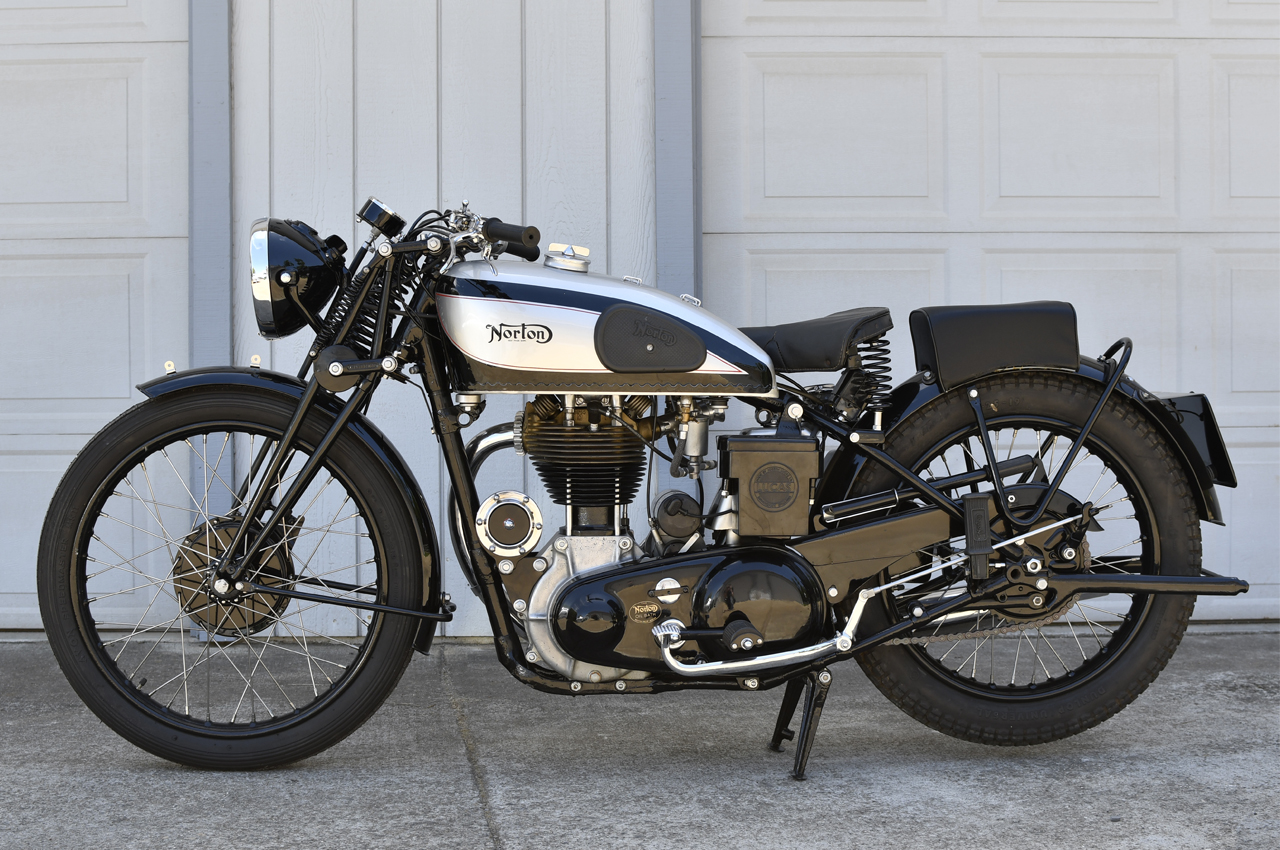
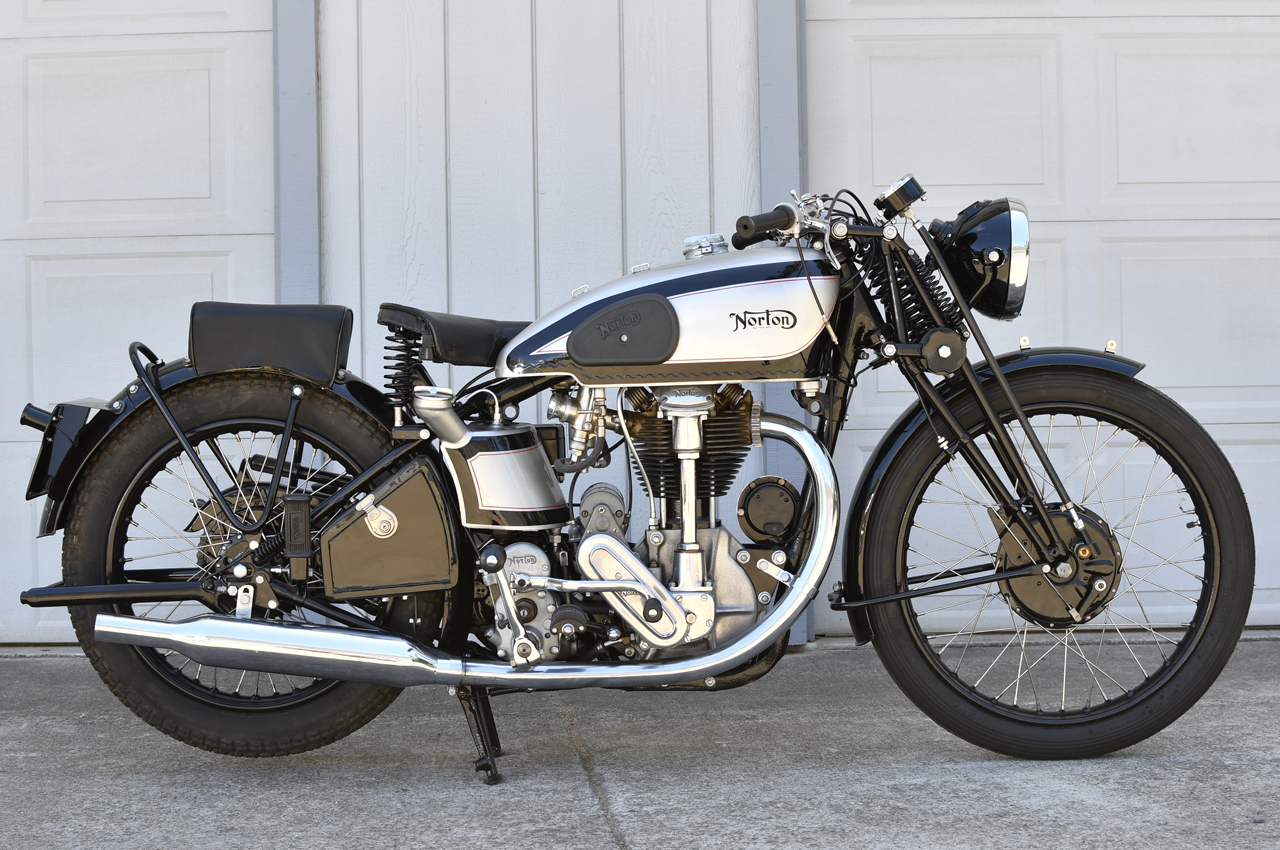
Very nice. There are likely…
- Log in to post comments
Robert, thank you for your…
Robert, thank you for your welcome. I appreciate you comment, "There are likely to be a few departures from standard." I suspect there are a number of departures... What little i know about pre-war Internationals, i suspect a number of them have experienced hardships during their use. I've been closely inspecting the bike end to end and top to bottom and found a number of things I've been correcting. I am taking my time with the Inter and will try to give it consistent attention as i continue to post forward what i find, questions i have and how to proceed with some of the corrections. With that in mind, i bought a 5 year membership, so you can expect to hear more from me in the future... I i fully intend on doing the reading necessary to avoid asking questions i can learn myself and at the same time i am really looking forward to learning from the hands of experience present on this fine site. I also have a 1974 Commando that i restored back in 2008-2010 and as such in my earlier life have a joyous history with a '74 i bought new in April of 1974.
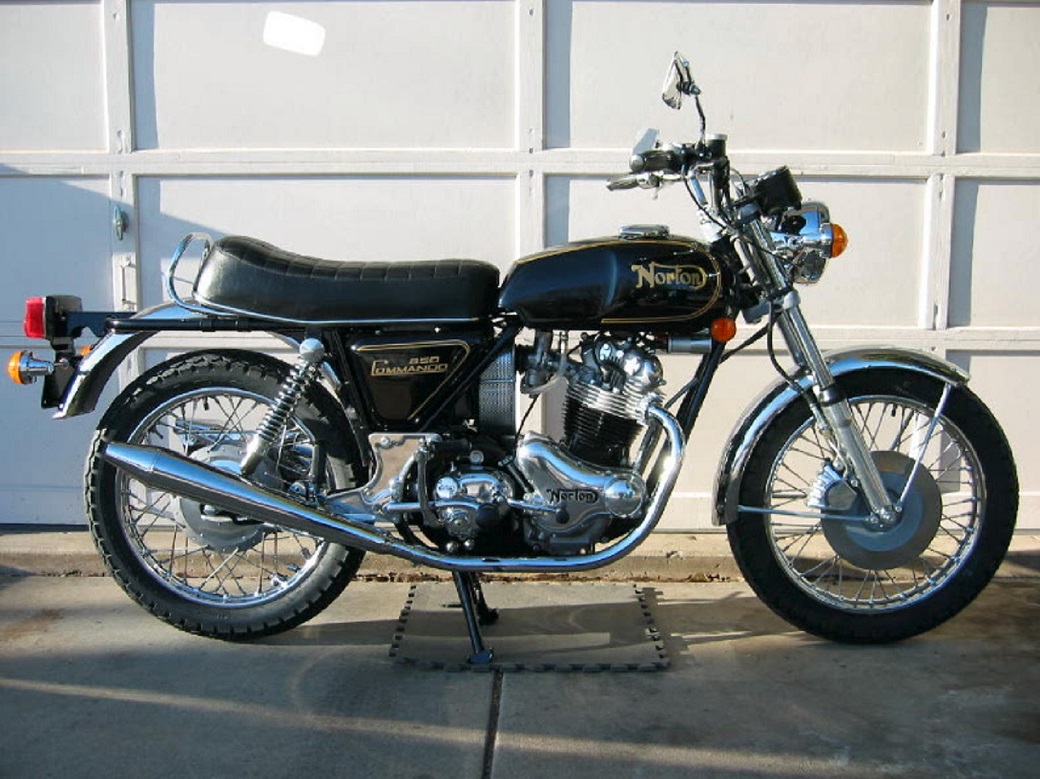 Again, thank you for your welcome!
Again, thank you for your welcome!
- Log in to post comments
Departures from standard pluses
Agree with Robert that there are a few oddities but nothing to detract from a beautiful machine. No expert but the forks with the high level adjuster position for brake suggest race pedigree... as does the chin rest loops on the tank.
Run it and enjoy it ...
PS: Seat spring mounts, steering damper and gear lever may need reviewing ....
looking forward to update
Jon
- Log in to post comments
Hi Jonathan,Thank you for…
Hi Jonathan,
Thank you for your reply. I'm unabashed in admitting "I don't know." That being said i don't know the features of spring mounts needing review. If it's not too much trouble, i would appreciate if you could share you thoughts as to why a review is needed about the features of the seat spring mounts, steering damper and gear lever. Or direct me to a literary source so i can learn more, i would appreciate that as well. I'm more curious than anything else to learn about my bike in relation to "what is" contrasted with "what was..."
The above being said, I'd appreciate if you will help me understand your observation of "the forks with the high level adjuster position for brake suggest race pedigree," as I don't know what "forks with a high level adjuster is. The tank with chin rest loops i think at least have some understanding of, sound like the tank with loops was not fitted to the standard road model...?
I've been collecting as many original pictures and information as i can to help me distinguish what i see on my bike in contrast to what i see in original pictures... With all my bikes, i love anything related to the bike and will try to gather what i can, literature, tools,accoutrements, etc.
Otherwise, fully agreed to "Run it and enjoy it ..."
Kind regards,
Steve
- Log in to post comments
Learning that I don’t know....
... is what draws me to this club. There are real experienced Norton keepers here. And as Ian points out vintageNorton site is one I have read every thread on. We are lucky that there are original racers, retro racers and tuning specialist here still kicking and passing on their experience to the new keepers.
The seat springs are normally seated on studs from lugs on the frame through the centre of the spring secured with nut and washer.
Steering damper seems to be of featherbed frame type. I’m not 100% on this ...
Gear lever was straight on that model, though many fit this one for comfort.
The girder forks used for the works racers had the brake cable adjuster mounted closer to the rider so he could take up slack on the move. Rears sometimes had the set up reversed for similar reason, butterfly nut at pedal end of rod (54?).
Steel tank with loops but not bolt through, suggest modified to suit but again not 100%
I will prepare a list of the books I reference so you can keep an eye out for them sometimes cheap often not.
What time zone are you in ?
happy to chat...
best regards
Jon
- Log in to post comments
Thanks, Jon...
...for discussing the distinguishing features a bit more that you're seeing on my '37. Going through what you've noted, i shall do my best to reply in kind and provide some less than the best pictures i have a this moment to share... And am happy to take more when clarification is needed!
In response to what you've noted...
1. "The seat springs are normally seated on studs from lugs on the frame through the centre of the spring secured with nut and washer." Are you saying the stud was part of the bracket? What I have here is some sor of hex “pillar/post” that threads into the angled bracket that is held by a bolt to the frame…?
2. "Steering damper seems to be of Featherbed frame type." Attached is a better picture of the steering damper…
3. "The girder forks used for the works racers had the brake cable adjuster mounted closer to the rider so he could take up slack on the move. " I haven’t been able to find factory pictures of 1937 Model 30 to compare to what is on my ’37, and what is hard to tell looking at the 1935 and 1939 factory pics I have it would appear (again, hard to tell) that the cable adjuster is up high…?
4. "Rears sometimes had the set up reversed for similar reason, butterfly nut at pedal end of rod (54?)." Definitely don’t have that!
5. “Steel tank with loops but not bolt through, suggest modified to suit but again not 100%.” Yes, I’ve noted different tank variations… 4-bolt through and no bolt through… So, i am confused with what tank I actually might have... Speaking of fixing the tank to frame… Here is likely one piece of ugly truth I have found… The top frame tube angling down from steering head has a cast lug on it for which the tank is such that it has 1 threaded hole on each side on rear of tank to bolt to the cast lug on each side of the frame. On my bike the RH lug at rear has been savagely ground off after frame having been painted, so the tank only fastens at the rear on the LH side… Yikes…..! Thoughts, anyone? Please?
6. “Gear lever was straight on that model, though many fit this one for comfort.” Again, I do not have any factory ’37 photos, so what I see on modern pictures of ’37 machines is straight and curved. However factory picture of 1939 CS1 and Model 40 shows a curved lever, 1936 brochure shows Model 40 shows straight lever and in understand what you are saying, 1937 would be fitted with straight lever…
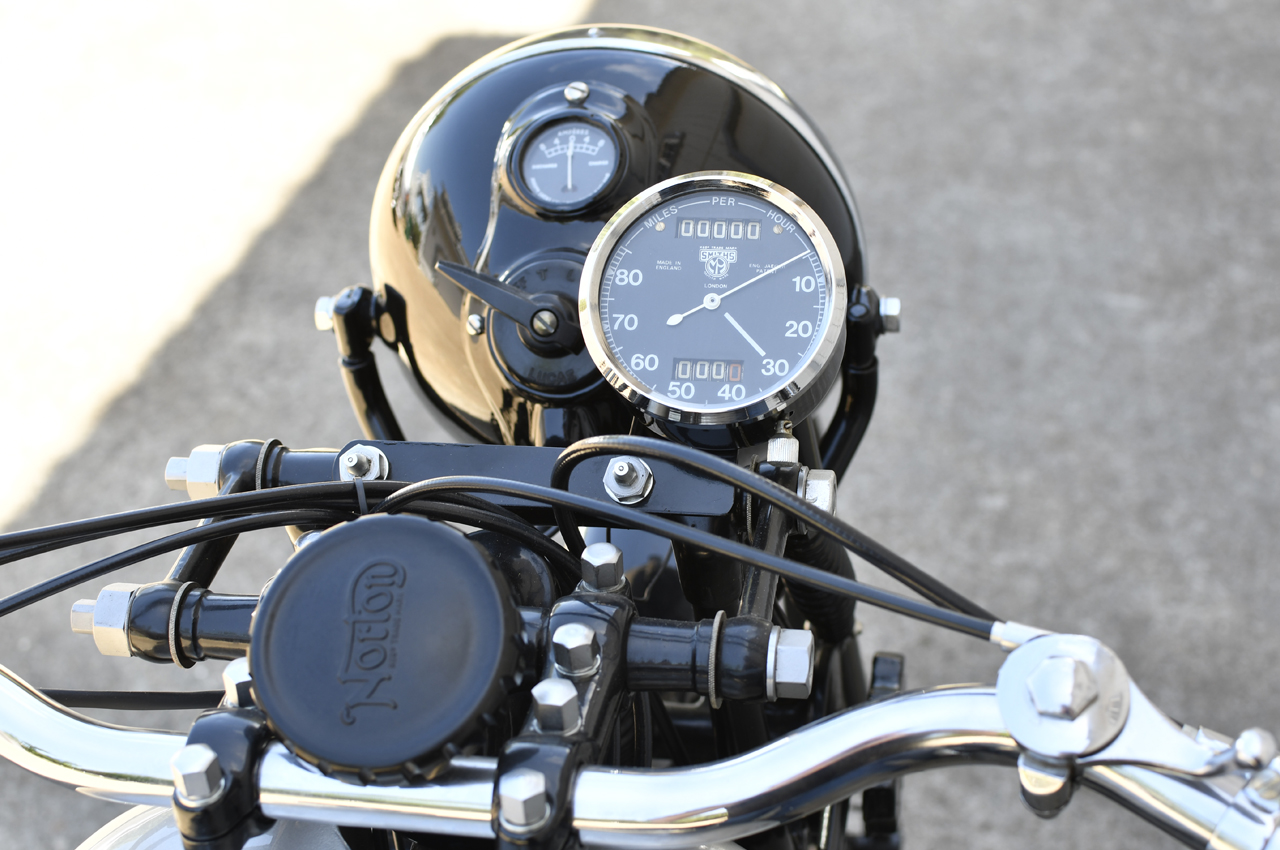
- Log in to post comments
Your point: 1 - “Normally”…
Your point:
1 - “Normally” the stud that holds the angled bracket would go through the centre of the spring. This would bring the seat further forward. But modified like this may suit the rider.
2. - As David said the Andre Steering damper was the type fitted to this machine mounted on a torque arm under the headstock.
5. - I can’t decipher your front tank description. The alloy bar should mount on two fixings onto that cast platform lug. The rear is demountable so can be replaced. It is stepped from side to side.
6. - I think all M30 had a straight lever. Maybe wrong...
what time zone you in ?
Will come back on weekend with anything I have to help.
Remember, riding it is the authentic thing. The rest is for bean counters...
Jon
- Log in to post comments
Welcome
Welcome Steve. As others have commented, you have a great looking International.
Just one thing, I would really look closely at your frame number.
My Inter was built in July 1937 and has an engine number about 600 before yours. I think your frame number is more likely to be 85502 as mine, as confirmed by the production records is 81764. A frame number of 35502 would date the frame to 1929. Your frame has the turned up radiussed front bottom cradle which is correct for a 1937 frame.
- Log in to post comments
Hello Ian, thank you for…
Hello Ian, thank you for your welcome.
For transparency's sake, i shall be forthright in my admission i have much to learn about my 37. I very much appreciate your comments on frame numbers; your comments are exactly the sort of thing I hope to receive as i continue posting henceforth.
The 35502 number, i must admit, is what the previous owner listed and after my inspection of this number found on LH side of the upper lug. I have again looked closely at this number and as such, the numeral "3" is distinct however the font is not the font viewed in this 3; the upper half of the 3 has the "pointed" upper half instead of being round as we see in this 3. Hope that makes sense... I am attaching a picture that hopefully shows the figures as there is likely some wear as well as the figures being filled with paint... What i see is an indistinguishable figure in front of the "3" followed by a space and then the figures "5502." as such, the figures i "think" i am seeing are "?3 5502" Push comes to shove, I may need to remove the paint so i can see better what appears to be a figure in front of the "3" My imaginative eye wants to say that figure looks like an "A"...
In any event, i shall leave our discussion about frame numbers and await your thoughtful comments about what i've shared. Again, thank you for your welcome observations.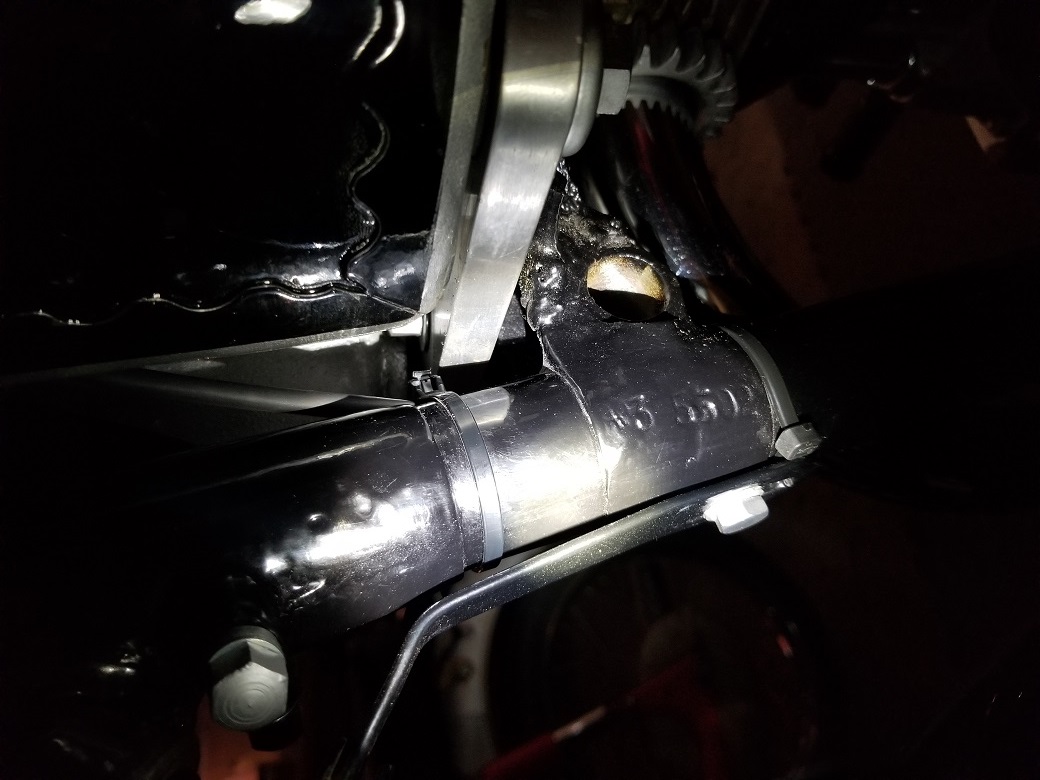
- Log in to post comments
"Your frame has the turned up radiussed front bottom cradle...
...which is correct for a 1937 frame." Ian, here is a better pic to show turned up front frame lug which encourages me... if you could further share your thoughts on my reply to your comments about frame number should begin with the number "8" i would appreciate it. And also, please read my reply to Jonathan about the RH rear lug that the RH rear of tank should fix to via a bolt, I would appreciate it.
Another thing is it seems the center stand fitted to my bike may not be the stand specific to the International... I have been looking at my Spares Books and discussing this on Norton Singles Facebook, the stand rubber on LH leg strikes the silencer, does not go over center which I would think it should, so it most dangerously will flip down, sometimes by itself... (i have it bungeed up for the tome being). Awaiting a Brooklands can from Armours, thinking might be able to the stand to go over center then... That, and I understand there is a possibility of making an adjustment in cam timing to remediate the loss of performance due to loss of back pressure running "the can..." otherwise, I may need to remove the stand, take more revealing pictures of it so you fellows can critique what the stand is
Oh, boy...! Learning, learning, learning!
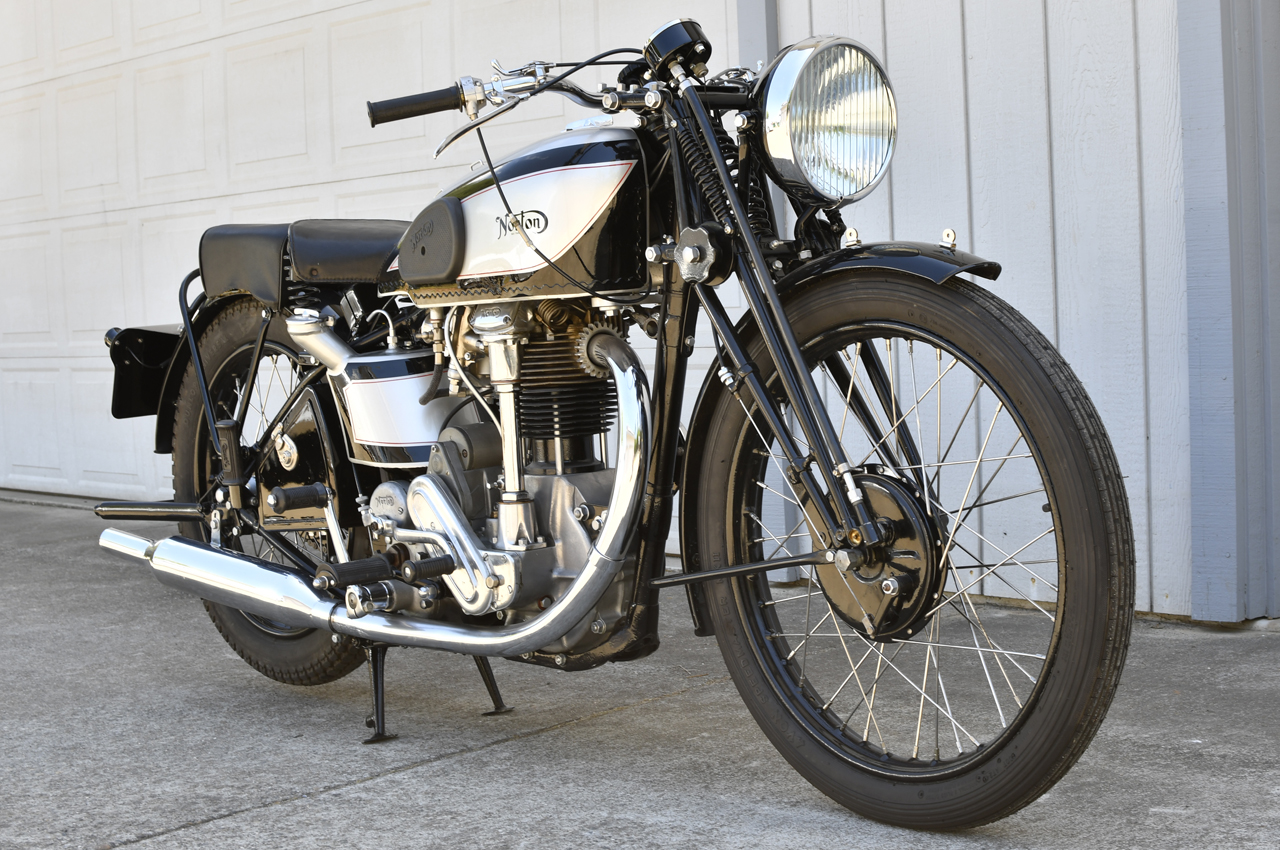
- Log in to post comments
Ian, further contemplation of your post...
My curiosity is increasingly piqued about engine, frame, and other numbers... Off the factory assembly line, were engine, frame and transmission number the same? I need to get a factory record certificate from the club, but first i need to clarify what the frame number is... Will appreciate your further thoughts on my reply about what i am seeing and picture i posted. I think i'm going to need to remove the paint over the frame number. The paint has filled in the numerals.
- Log in to post comments
Frame number and engine number.
Hi Steve,
From the start of production in late 1945, post war models had matching engine and frame numbers. Only early Commandos had matching engine, frame and gearbox numbers.
Prewar machines did not have matching engine and frame numbers making it difficult to determine if a fitted engine originally left the factory in it's frame. A confirmation from the factory records is the only way of knowing.
From my data from the factory records, from late 1926 until late 1936, the engine number was greater than the frame number but from then on until the end of prewar production the frame number is greater than the engine number. This is due to an entry error in the data where the person filling in the books started a new page and incorrectly started the page with frame numbers about 10,000 higher than the last entry on the previous page.
So prewar identification is difficult without getting a check from the factory records. No such problem with post war machines.
- Log in to post comments
Literary source
Hi Steve,
Best site, apart from what is on this site, is vintagenorton.com operated by Simon and John.
You can zero in on a particular year and model and they have plenty of photos.
Send me a personal message by clicking on my name and we can discuss in more detail than on the forum.
regards, Ian
- Log in to post comments
Ian, i clicked on your name..
...and i'm not sure where the message i wrote went or what it did.
I sure would like to get the frame number clarified on my machine.
Of what i am familiar with British motorcycle manufacturing, i would suspect a number of components making up an International were matching numbers leaving the factory...? This bike was built up from bits, so the only thing i know that has matching number is the cylinder and left crankcase. i have not attempted yet to peer up at the bottom of cases to see if there are number stamped on the belly suggesting the cases being a line bore matched pair...
- Log in to post comments
thankfully much literary resources
Ian, being on the front end of identifying and gathering the different resources i've been finding, vintagenorton.com was one i found early on and did go through it but did not remember that site again until you mentioned it. I just finished going through the 1935-1939 and model 30 sections, downloading pictures that seemed relevant to my '37 of which i could contrast and compare. I couldn't seem to find much information on the 1937 Model 30 and what i am a bit concerned with is how reliable looking a pre and post 1937 pictures will be to aid my learning to determine accurately what is and is not correct for a 1937. Being a realist, regardless of what is incorrect on my machine, i feel it rather possible finding the parts i need to correct features of the machine will be difficult... One thing i have not been able to find is any '37 factory literature. So far, it seems finding 1937 Model 30 specific information a bit more obscure...?
- Log in to post comments
Somewhat better pic of "hex pillar/post fixing lower part of...
...seat spring to angle bracket fixed by one bolt to frame...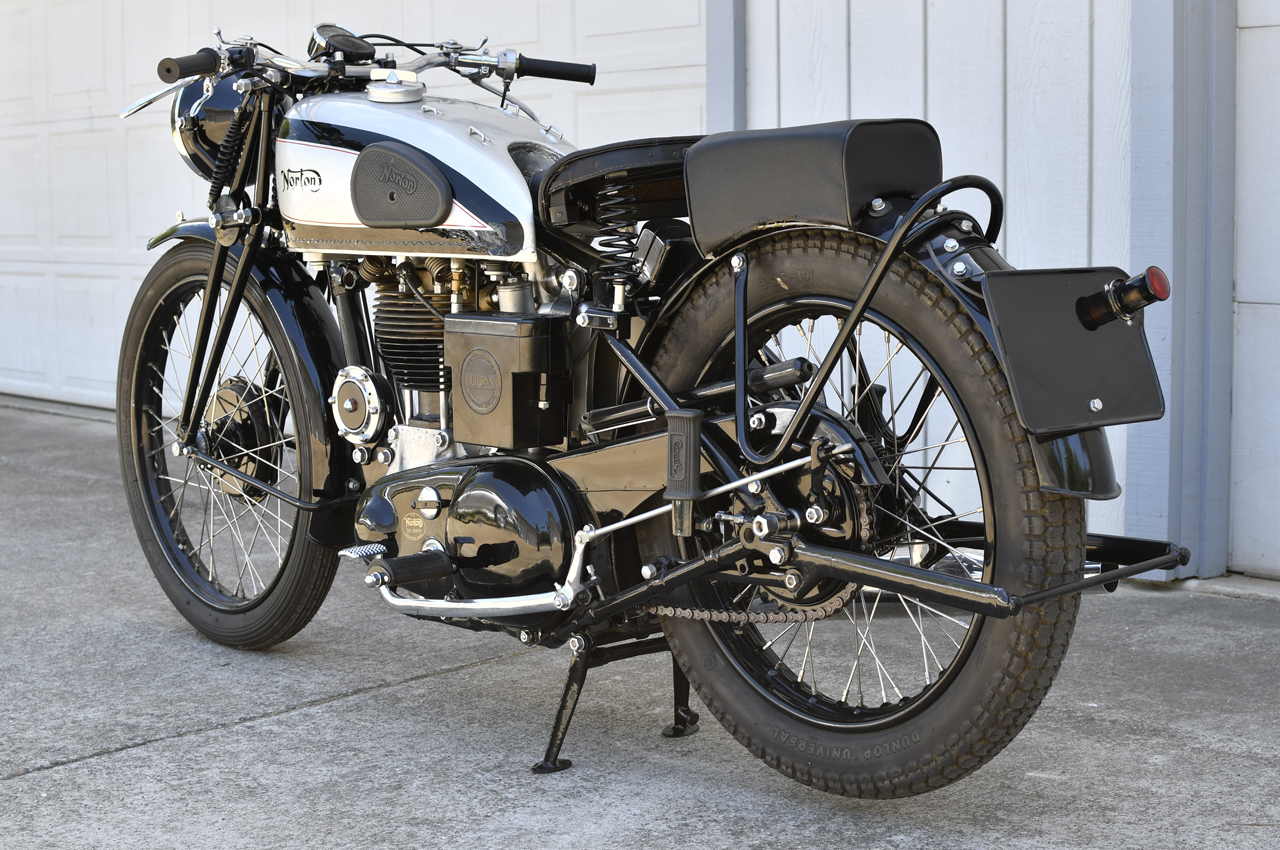
- Log in to post comments
If your frame is hard…
If your frame is hard stamped with number 3 and the registration document matches the frame...leave well alone! You don't want to stir up the proverbial hornet's nest in today's world.
As said above, the usual steering damper was the Andre damper, which sits with its friction discs above the fork. In the early 30's the reaction arm was bolted to the tank top. By the mid 30's there was a lug on the back of the head crown to take it. You should have the lug. Replica dampers are sold. Try 'racingvincent' web site if you feel the need. After the War they fitted the type you have, but by then they had telescopic forks.
Those bikes were used and abused on track and elsewhere and would all have been dropped a few times.
I believe tank support brackets are sold, but they would not be difficult to make. I think your front one is already an alloy flat bar.
Frankly I wouldn't worry too much about originality. It is difficult enough to achieve if you have easy access to a museum bike of the same period, and most of those are not as they left the factory. Other Inter owners will or should admire it for what it is. Those who snipe will do so out of a mixture of envy and ignorance!
How does it GO?!
- Log in to post comments
Its going to be a facinating…
Its going to be a facinating voyage of discovery to unravel the life and history of a machine like this. Are the engine and frame a pair ? Did they start life together?. Was the bike smashed and broken and the parts seperated for years ,possibly in different ownership, to be re-united by a chance advert . How much of the bike has been recreated by an enthusiast working in a shed over a lifetime?.All possible. The chance that its mostly an orriginal bike thats been restored is slim. Lets hope it works as well as it looks .We eagerly await the Head cam vid with enhanced sound effects of riding with the Brooklands can !!.
- Log in to post comments
Engine and frame numbers…
Engine and frame numbers were generally not very far from each other..to a few thousand...but did not match until the number sequences started again after the war. Gearbox numbers were entirely separate.
If you look at the back of the gearbox you should find it stamped with the ratios it left the factory with. Inters generally had close ratio boxes. Kick start boxes have a lower bottom gear, which helps in town or hilly country. Standard touring ratios (much the same as Commando) make more sense, but possibly devalue the bike!
If you have a toolbox like yours, the numbers aren't very easily seen anyway. And the internals might not even match the box numbers.
- Log in to post comments
Keeping my fingers crossed…
Keeping my fingers crossed for you. My experience has been that the Best cosmetically restored bikes are usually the worst for mechanical bodge ups !! I would now only be interested in a machine that exhibits the signs of lots of regular use.
- Log in to post comments
Dating cert
Will clear up a lot of your numbers issues. Chris Streather is the man behind the certs for your bike and is well versed in what you need. As David says, don’t get hung up on numbers or originality, very few if any are as shipped. I will look up my collection to see if there are specific 1937 details listed. My own model 30M is 1937 but has extensively altered over its life.
What you have is a beautiful riding machine. You can tweak the details as you go.
Cheers
Jon
- Log in to post comments
Frame number
Hi Steve,
What I was going to discuss with you is I think you may have unknowingly identified your frame.
I believe it is a 1946 Model 18 overhead valve frame as this would be identified by the following description:
(i) A small letter A. This is the year code for 1946
(ii) A number 3. This is the model designation for a Model 18 which was a rigid frame 500cc overhead valve single.
(iii) A space and then the actual frame number which in 1946 started at 1001 and finished around 7200 give or take. Your number 5502 fits this perfectly.
In 1946, girder forks were still fitted and the brake was on the right hand side.
My sales catalogue shows the brake cable adjuster high up where yours is as well.
There are a number of differences between o.h.c. and o.h.v./s.v. frames making It difficult to fit the engine in the roadster frame so the previous owner has done a good job. Look at the petrol tank mounting, seat spring fixing and the additional bracket for the muffler.
I wouldn't do anything to the bike. Just enjoy the ownership of an o.h.c. Norton
- Log in to post comments
1937 International photos.
Hi Steve,
Firstly we should really transfer this discussion to the Singles section of the forum.
I've attached a couple of photos from "The Roadholder" sales catalogue for 1937. Note the Andre steering damper which required a specific mounting point at the top of the frame just behind the bearings.
I can scan the photos in high def. when I get your email sddress.
- Log in to post comments
Under tank details
Ian here are a few shots under my tank to show the mount platform.
- Log in to post comments
Frame confirmation.
Hi Steve,
I can visually confirm Ian's identification of your frame as a 1946 Model 18. International rigid frames were not made after 1939 except for specific competition specials. The Model 18 has different tube lengths and lugs to an Inter and this gives the bike a different stance. See attached photo of a 1937 Inter. It may give you more insight if you look in the Singles section of this forum and the post titled "Looking at pre-war Internationals".
- Log in to post comments

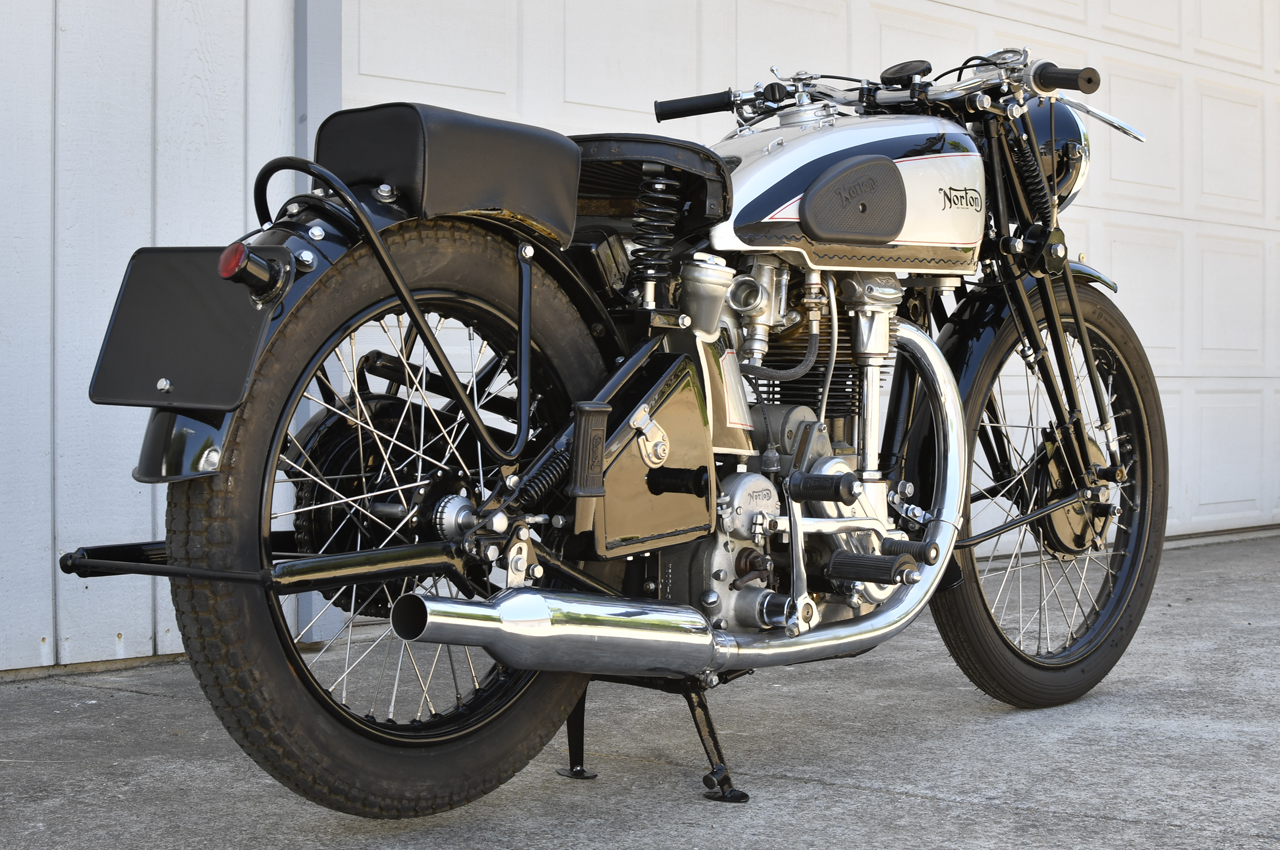



Very nice. There are likely to be a few departures from standard, but you are doing the right thing spending time with the machine to cement the bond before diving in. As long as it has oil where its needed , a primary chain with half an inch of slack to avoid damage to bearings and the engine does not get overheated you won't go far wrong. Stay away from traffic and enjoy.